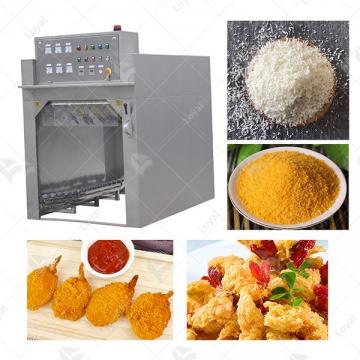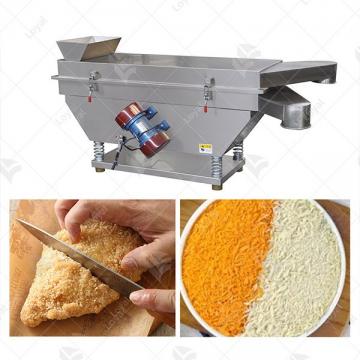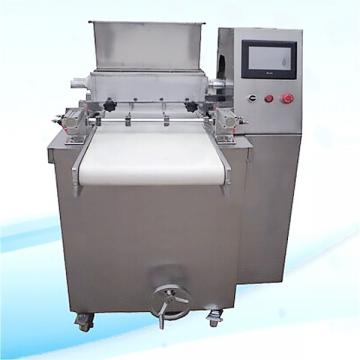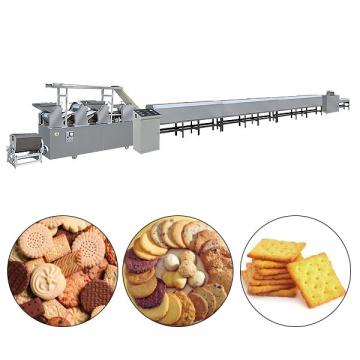
- Shandong Loyal Industrial Co.,Ltd.
- Macaroni Production Machine Instant Noodle Machine Biscuit Making Machine
Home> Company News> Understanding The Snack Business:The Ultimate Guide To Snack Business

Understanding The Snack Business:The Ultimate Guide To Snack Business
2025-01-23 16:45:46Introduction
The snack business is one of the fastest-growing sectors in the global food industry, with consumer demand consistently on the rise. As the market becomes increasingly competitive, snack manufacturers face the challenge of maximizing production efficiency while ensuring high product quality. This is where fully automatic, high-efficiency, energy-saving equipment comes into play.
In today’s industry, the ability to scale production without compromising on quality or increasing operational costs is crucial. Efficient equipment not only reduces overhead but also improves the sustainability of operations. In this article, we will explore how advanced automation technologies and energy-saving machinery can significantly enhance the snack business, enabling businesses to stay competitive and meet the growing demands of consumers.
Automation is no longer a luxury but a necessity for snack producers looking to boost productivity and remain cost-effective. By integrating fully automatic systems, companies can streamline their production processes, reduce human error, and ensure consistent quality. Furthermore, as energy costs continue to rise, investing in energy-saving technologies has become an essential step for companies aiming to reduce operating costs and improve their bottom line.
In this article, we will delve into the importance of these advancements, examining how snack businesses can benefit from the latest machinery and technology to stay ahead of the curve.

Key Features of High-Efficiency, Energy-Saving Equipment
As the demand for snacks continues to grow, manufacturers are increasingly looking to optimize their operations not only in terms of productivity but also in energy consumption. High-efficiency, energy-saving equipment plays a crucial role in reducing operational costs, minimizing environmental impact, and ensuring sustainable growth for snack businesses. Let’s explore the key features of these technologies and how they contribute to a more cost-effective and sustainable production process.
Overview of Energy-Saving Technologies in Snack Production
In the snack business, energy consumption can account for a significant portion of operational costs. As such, investing in high-efficiency, energy-saving equipment is a smart way to reduce energy usage and lower production costs. Modern snack production equipment is equipped with advanced energy-saving technologies that optimize power consumption, minimize waste, and ensure efficient resource usage.
For example, electric ovens used in baking or frying snacks are designed to operate at a higher thermal efficiency, which means they use less energy to achieve the same output. Similarly, energy-efficient motors in mixers and extruders use less electricity while maintaining the same level of performance. These innovations not only reduce energy consumption but also lower greenhouse gas emissions, making snack production more environmentally friendly.
How High-Efficiency Machinery Improves Production Speed and Reduces Energy Consumption
The efficiency of modern snack production equipment goes beyond energy savings—it also improves production speed. High-efficiency machinery often features faster heating, cooling, and processing times, which directly increases output and reduces energy waste. By optimizing the way energy is used during production, these systems contribute to both faster production and lower operational costs.
For example, vacuum fryers, commonly used in the snack industry for products like potato chips or fruit crisps, operate at lower temperatures compared to traditional frying methods, reducing energy consumption while maintaining the quality of the product. The use of heat recovery systems in these machines allows businesses to reuse excess heat, further lowering energy costs.
Examples of Innovative, Energy-Saving Equipment in the Snack Business
Several examples of innovative, energy-saving equipment are transforming the snack industry. Here are some notable technologies:
Automated Snack Cooking Systems: These systems are designed to optimize cooking processes by controlling heat, air circulation, and cooking time, ensuring uniform product quality while consuming less energy. Some systems even integrate smart sensors that adjust the cooking environment in real-time, maximizing energy efficiency.
Efficient Packaging Solutions: Packaging plays a crucial role in snack production, and energy-efficient packaging machines are gaining popularity. These machines use advanced automation to minimize packaging material waste, reducing the need for excess energy during the production process. Additionally, some machines are designed to operate at lower speeds without compromising the speed of packaging, further reducing energy usage.
Intelligent Temperature Control Systems: These systems are widely used in ovens, fryers, and cooling tunnels. They use sensors to monitor and adjust the temperature based on real-time conditions, preventing energy waste by maintaining optimal production temperatures throughout the process.

Benefits of Investing in Fully Automatic Equipment for Your Snack Business
Investing in fully automatic equipment offers numerous benefits for snack manufacturers. From reducing operational costs to increasing production output, the advantages of automation extend far beyond just improving efficiency. Let’s explore the key benefits that can help your snack business thrive in today’s competitive market.
Long-Term Cost Savings on Energy and Labor
One of the primary advantages of fully automatic systems is the long-term savings on labor and energy costs. Automation allows businesses to reduce reliance on manual labor by automating repetitive tasks, such as mixing ingredients, frying, and packaging. This reduction in labor costs is particularly significant for snack businesses that require high-volume production.
Moreover, high-efficiency equipment that incorporates energy-saving technologies can drastically cut energy consumption. By using less power to achieve the same output, snack manufacturers can lower their utility bills, contributing to significant cost savings over time. As energy prices continue to rise, making the switch to energy-efficient machinery becomes not only a practical move but also a financially savvy one.
Increased Production Output and Scalability
Another critical benefit of fully automatic equipment is its ability to increase production output. With automated systems operating at faster speeds and with greater consistency, snack businesses can produce higher volumes of products in less time. This leads to more products available for sale, which directly translates to increased revenue.
In addition to increasing production speed, automation enhances scalability. Fully automatic systems can be easily adjusted or expanded to accommodate higher production demands. Whether your snack business is expanding to meet new customer demands or diversifying product lines, automated systems can scale efficiently without the need for extensive manual intervention or additional labor.
Improved Sustainability and Environmental Impact
In an era of growing environmental consciousness, sustainability has become a key factor for businesses, especially those in the food industry. Fully automatic, energy-saving equipment plays a significant role in improving the environmental footprint of a snack business. By reducing energy consumption and minimizing waste, manufacturers can operate more sustainably and meet increasingly stringent environmental regulations.
For example, automated systems with energy recovery technologies, such as heat exchangers, allow businesses to reuse heat generated during production, thereby reducing the need for additional energy inputs. Additionally, automation can help optimize raw material usage, reducing waste and making the most of available resources. These sustainability benefits not only help snack businesses align with eco-friendly practices but can also improve their brand image and appeal to environmentally conscious consumers.
Overall, investing in fully automatic equipment leads to tangible financial savings, increased production efficiency, and a reduced environmental impact—making it an essential strategy for modern snack businesses aiming for growth and sustainability.

How to Integrate Fully Automatic Equipment into Your Snack Business
Integrating fully automatic, high-efficiency, energy-saving equipment into your snack business is a pivotal step toward enhancing your operational efficiency, reducing costs, and meeting production demands. However, the process of incorporating automation into your existing setup requires careful planning and strategic execution. Below, we’ll outline the key steps for seamless integration, ensuring your snack business can benefit from automation without disrupting current operations.
Steps to Assess and Select the Right Equipment for Your Production Needs
The first critical step in successfully integrating automation is to assess your current production processes. This evaluation helps identify the specific areas where fully automatic systems can add the most value. Consider factors such as the variety of snacks you produce, production volume, quality standards, and any existing bottlenecks in your production process.
Partnering with specialized suppliers who understand the unique requirements of the snack business can help guide you toward the best equipment for your needs. Experienced manufacturers can offer customized solutions to suit your specific production goals, whether that’s reducing energy consumption, increasing production speed, or maintaining consistent quality.
Tips for Smooth Integration with Existing Operations
Successfully integrating fully automatic equipment into your existing snack production line requires careful coordination and planning to minimize downtime and disruption. Here are some essential tips for a smooth integration process:
Pilot Test the Equipment: Before fully rolling out the new equipment, conduct a pilot test to assess its performance in real production conditions. This allows you to address potential issues early on and ensure the machinery fits seamlessly into your current workflow.
Infrastructure Upgrades: Depending on the automation machinery you're integrating, there may be a need for infrastructure adjustments, such as upgrading electrical systems, plumbing, or ventilation. Ensure your facility can accommodate the new equipment without compromising production efficiency.
Workflow Optimization: Automation is most effective when it complements your existing production workflow. During the integration process, ensure that the new machines are positioned strategically within the production line to avoid bottlenecks. Work with automation experts to plan the optimal layout and ensure that each automated system enhances the overall production process.
Scalability and Future-Proofing: When selecting fully automatic equipment, think about your business’s long-term growth. The equipment should be scalable to meet future production demands or accommodate product line expansion. Choosing modular, flexible systems will allow you to add or upgrade machinery as your business evolves.
Training Your Workforce to Handle New Technologies
Introducing fully automatic equipment requires upskilling your workforce to ensure they can operate, troubleshoot, and maintain the new machinery efficiently. Proper training is crucial to maximizing the benefits of automation and preventing costly mistakes.
Invest in training programs that focus on:
Operating Automated Systems: Your team must understand how to operate automated equipment efficiently and safely, including setting up, starting, and stopping the machinery.
Basic Troubleshooting: While automated systems require less hands-on intervention, operators should be trained to address common issues, such as system malfunctions or minor technical glitches.
Routine Maintenance: Teaching employees how to perform basic maintenance, such as cleaning, inspecting, and replacing parts, will help maintain the longevity of the equipment and prevent downtime.
Data Analysis: Automation systems often generate valuable production data. Train your team to monitor and interpret this data to track production performance and identify areas for further improvement.
A well-trained workforce will be crucial to ensuring the successful integration of fully automatic equipment and ensuring maximum efficiency, productivity, and cost savings over the long term.
By following these steps, your snack business can integrate high-efficiency, energy-saving equipment into your operations smoothly and effectively, resulting in enhanced productivity, reduced costs, and improved product quality.

Conclusion
In today’s competitive landscape, fully automatic, high-efficiency, energy-saving equipment is not just a luxury for snack businesses—it’s a necessity. By embracing automation, companies can streamline their production processes, reduce labor and energy costs, and significantly enhance product consistency. The integration of advanced machinery also opens doors to sustainable growth, allowing businesses to meet rising consumer demands while maintaining a focus on cost-effectiveness and environmental responsibility.
As we’ve seen, the benefits of adopting automation and energy-saving technologies extend far beyond improving operational efficiency. These innovations also provide snack businesses with a competitive edge, enabling them to scale production, enhance product quality, and reduce waste. For manufacturers looking to thrive in a fast-paced market, investing in fully automatic equipment is a forward-thinking approach that can drive significant long-term value.
By understanding the importance of automation, assessing production needs, and strategically integrating the right equipment, snack businesses can unlock greater productivity, higher profitability, and improved sustainability. With the right machinery in place, your snack business will be well-positioned to meet the demands of the modern food industry while driving growth and innovation.
Embrace the future of snack production—invest in fully automatic, high-efficiency, energy-saving equipment today and take your business to new heights.
Reference
The following are five authoritative foreign literature websites in the field of Industrial food machinery:
1. Food Engineering Magazine
Website: https://www.foodengineeringmag.com/
2.Food Processing Magazine
Website: https://www.foodprocessing.com/
3.Journal of Food Engineering
Website:https://www.journals.elsevier.com/journal-of-food-engineering
4. Food Manufacturing Magazine
Website:https://www.foodmanufacturing.com/
5. International Journal of Food Science & Technology
Website:https://onlinelibrary.wiley.com/
 Commercial Japanese Panko Bread Crumb Grinder Machine
Commercial Japanese Panko Bread Crumb Grinder Machine Japanese Bread Crumbs Processing Line
Japanese Bread Crumbs Processing Line Automatic Cookies Making Machines
Automatic Cookies Making Machines Fully Automatic Biscuit Making Machines
Fully Automatic Biscuit Making Machines